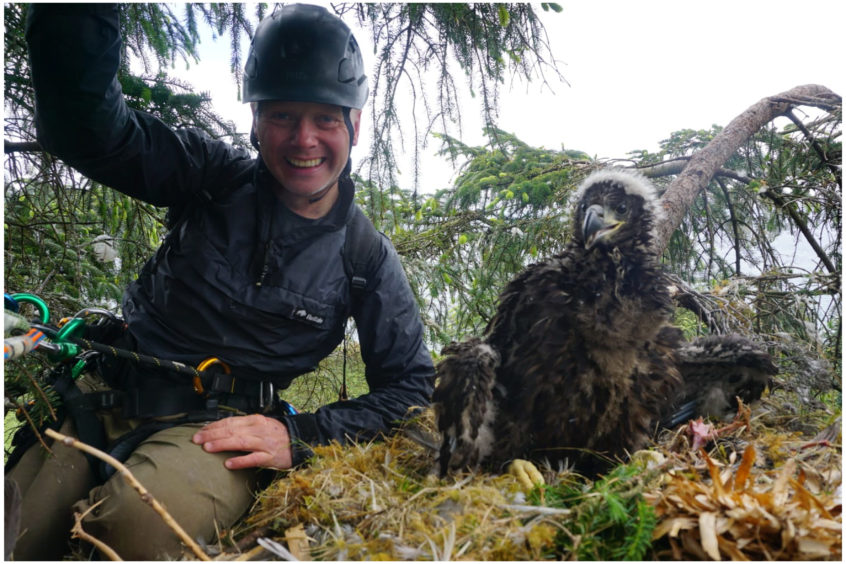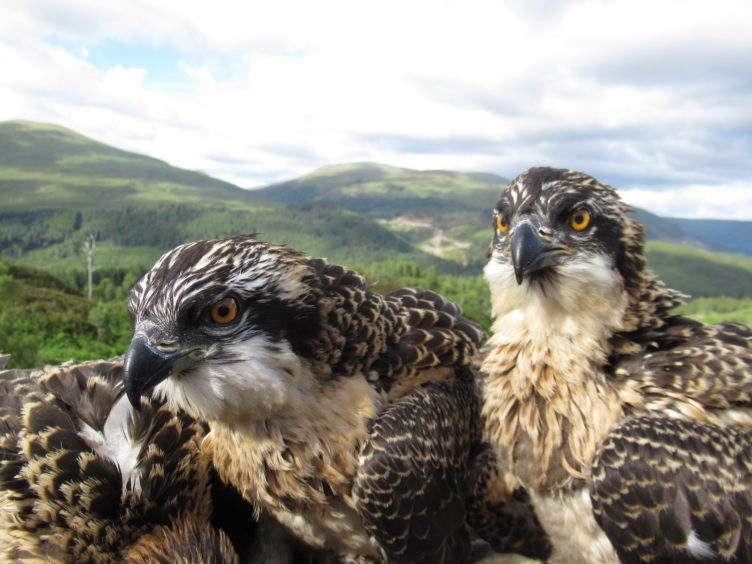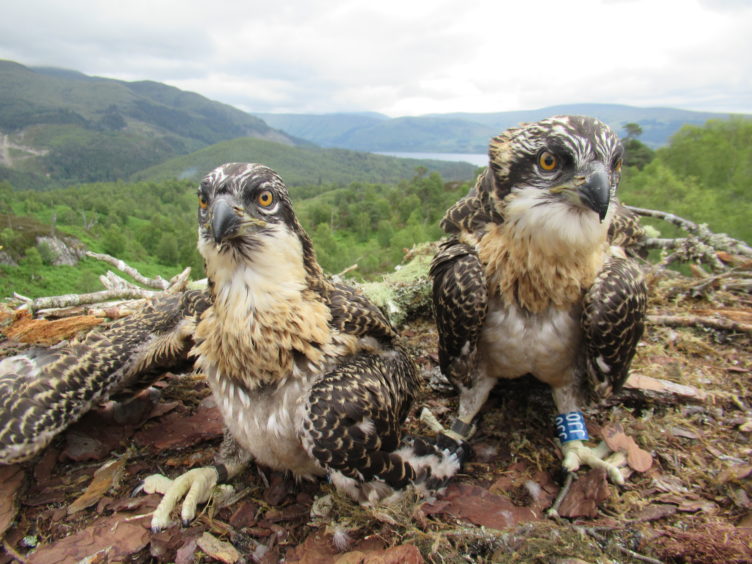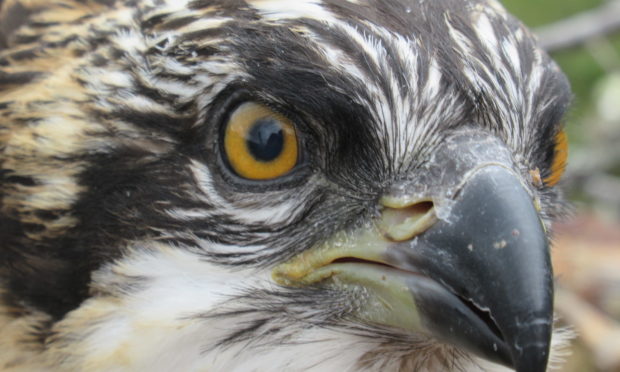There is the distant chirp of bird song and the muffling of the wind, as three osprey chicks sit comfortably in their nest.
They appear to be indulging in a preening session, and the camera picks up the ruffling of their young feathers in exquisite detail.
Their watchful father, Louis, is perched just out of sight – surveying his kingdom of Loch Arkaig Pine Forest, which is tucked away between Fort William and Inverness.
From the vantage point of the nest is a canopy of green, which has been admired by thousands of people around the world.
From the US to Australia, you need not have set foot in Scotland in order to follow the story of resident osprey pair Louis and Aila.
Thanks to a live camera rigged by the nest, you can check in on the young family 24 hours a day.
If you’re lucky, you might see Aila swooping in with a trout as the chicks eagerly cheep for their dinner.
The fascinating footage has become a lifeline for people living through lockdown.
From improving mental health to raising awareness about the osprey population, The Woodland Trust is hopeful that the osprey cam will continue to do good for the protected species.
The woodland conservation charity has been streaming footage of breeding ospreys from Loch Arkaig Pine Forest since 2017 – when thousands of people tuned in to watch the daily struggles of a pair of ospreys as they attempted to raise a family.
Last year, around 60,000 people watched the trials and tribulations of a bird we previously knew little about, compared to 290,000 viewers in 2020 so far.
The ambitious project saw a nest created, with the open-topped structure of a mature Scots pine as the base.
Camera equipment was manually hefted uphill through trees, bog and thigh-high heather.
A south-facing solar panel the size of a dinner table was then set up.
After the sun clears the ridge behind the loch each morning, the panel charges a battery which powers a weather-resistant CCTV camera fixed at the nest.

Dozens of volunteers have been involved in making osprey cam a reality, including ecological consultant Lewis Pate.
He is fresh from ringing golden eagles when we catch up, and admits there was some scratching involved.
“It can be quite painful and I’m not getting any younger,” he jokes.
It’s not uncommon for Lewis to find himself just inches from a young chick, be that eagle or osprey.
With just ropes and a harness, Lewis makes the ascent in order to place a ring on the leg – meaning the bird can be tracked for many years to come.
Lewis is passionate about the conservation of raptors, and is preparing to ring the osprey chicks in the coming weeks.
Thankfully ospreys are relatively placid, meaning Lewis won’t be dive-bombed when he finally gets to see the family up close.
“Short of spending hours in a cold, damp hide with a scope, there is no way to learn the intimate details of osprey behaviour,” said Lewis.
“All the books in the world do not have the answers that good field work can give you, but being able to switch on the nest camera over breakfast has been amazing.”
Although Lewis is now a mine of information, he didn’t always work with wildlife, after swapping a desk job for birds of prey.
“I used to be a business manager many years ago, but it wasn’t particularly fulfilling,” he says.
I wanted to do something totally different, so I worked as a countryside ranger in Perthshire.
Then I got a job with The Scottish Wildlife Trust, I was involved with red squirrel conservation and spent four years at Loch Lomond.
“Now I’m self-employed, which is interesting under the current climate.”
What can Lewis tell us about ospreys, which are still rarer in the UK than golden eagles – having previously been hunted to extinction in Europe?
“I think there has been a bit of luck involved,” admits Lewis.
“You don’t put a camera up and the ospreys will tap dance.
“They’re a great species as they’re not camera shy though. They’re happy to sit and look at the camera.
“We’ve had triplets this year which is lovely. Will they survive? Well, hopefully.
“The really good thing about ospreys is that they tend to come back to the exact same site they bred on the year before.
“They fly around 3,000 miles of migration from Africa, and yet they always return. No one knows how they do that, although they only come to Scotland for a holiday.
“The live camera has raised the profile of ospreys enormously. The vast majority of people who support The Woodland Trust will never see an osprey in the wild, or even set foot in the pine forest. This has enabled us to capture their attention and connect them with their environment.
“It is a really important thing to do, when people’s mental health is at risk during lockdown. To connect people with something outside, which is inspiring to watch.”
Ospreys mate for life but migrate separately, and have a perilous journey to make.
“The young don’t come straight back, they grow and learn out in Africa,” explains Lewis.

“One of the biggest problems is the migratory passage. They cross countries where the environmental controls and fashion isn’t always to protect birds of prey, which are still eaten in some countries.”
Ospreys are also up against toxic insecticide, which can prove deadly when they enter the food chain.
“In Africa, for example, there is an insecticide which is used to kill mosquitos,” says Lewis.
“Malaria is obviously a big issue for public health. That insecticide is focused into the aquatic food chain, and any toxins are magnified to the top.
“What is at the top of the food chain? Ospreys.
“During the 1960s, ospreys suffered terribly with the thinning of egg shells. The toxin stopped them producing calcium, which give eggs their strength.
“It decimated osprey populations, up to 95% in some places.
“People also used to kill ospreys for taxidermy, for skins and for their feathers. Thankfully we have moved beyond that.”
Ospreys tend to migrate in August and September, although they can migrate earlier if they do not have young.
“I class ospreys as an African bird, having their summer holidays in Scotland,” says Lewis.
“We are getting a glimpse of them at a really interesting time in their lives.”
Lewis believes that Aila and Louis have improved at parenting, with their escapades amusing to watch.
When the osprey cam was originally set up, the breeding pair on the site were not so lucky.
“The eggs were stolen by a pine martin three years ago; it ran up the tree and took all three eggs,” says Lewis.
“The female was dive-bombing it, but it made no difference. We’ve since protected the bottom of the tree, and an electric wire has solved that problem.
“I remember bringing my son home from the hospital, and not having a clue what to do. Ospreys are no different.
“They were hilarious, standing over the eggs and tripping over the young. They have improved though, and they’ve got a few migrations under their belts.
“They are bringing in fish multiple times a day, they are pretty experienced.
“Their diet is predominately fish, they don’t eat much else in Scotland. Ospreys are very adept fishermen though.
“We think Aila and Louis are going a fair distance as well, around 15 kilometres away to Loch Linnhe – and they’re also fishing in hill lochs.
“There are certainly a few pairs of ospreys that we probably don’t know about.
“To be able to learn about them and the journey they make, it’s quite something.”
Bird’s eye view
Liz Bracken lives on the northern shore of Loch Arkaig, around one mile from the nest.
She has a telescope trained on the nest, and enjoys spectacular views across the loch from her living room window.
Liz keeps an eye out for ospreys returning to the loch each spring, and currently volunteers on the social media team – to keep people up to date.
“I have always been interested in ospreys, since I knew they had returned to the area,” says Liz.

“Lockdown has had a remarkable effect on the number of people viewing the footage.
“You get really emotionally attached to the ospreys, and you wish them well, you want the best for them. I think they are such iconic birds of prey, and an amazing example of nature surviving against the odds.
“I’m a sucker for the underdog.”
